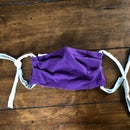Introduction: Cooking 101: How to Perfectly Pan-Sear Meat With a Pan Sauce
Searing meat is super simple and and practical, a core technique every good chef should have in their repertoire. By definition, searing is a technique where meat is cooked at a high heat to form a caramelized crust. Not only is it pretty simple, but it makes for a mouthwateringly delicious piece of meat and creates a ton of flavor! So in this instructable, I'll show you how to sear steaks and chops to their juicy, flavorful fullest, and use their juices to create a simple pan sauce.
This is meant to be more of an application/technique, rather than a recipe to follow. The ingredients can change as you wish, and you don't really need to look at a recipe after you sear meat once.
If you like this instructable, please give it your vote in the Cooking Basics challenge, and remember to comment!
Step 1: Gather Your Ingredients
There are only a few components necessary to sear meat and make a pan sauce:
Meat (duh)- The meat you choose needs to be an inch or less thick for searing. The best types for searing are:
Ribeye
Strip steak
Filet mignon
Top sirloin
Flank steak
Boneless pork chops
Meat seasonings- Kosher salt and Freshly ground pepper
Aromatics- 1 shallot, 1-2 cloves of garlic, 1 small onion, or 1 leek, all minced
Liquid- choose strong liquid: Wine, Broth, Cider, Orange juice
Butter- 2-3 pats, very cold
Finishers- Herbs (preferably fresh), vinegar, mustard, horseradish, etc. (I'm using a mix of basil, oregano, and thyme)
Step 2: Cut to Desired Pieces
Trim the fat around the meat until almost none is left. I'm using a mix of sirloin and ribeye. Too much fat will make the meat splatter on the pan, so make sure it's all gone.
Cut the meat based off of how it will be prepared. If used for a stew, for instance, cut into small chunks. I'm not going to cut my meat because I am preparing each piece to be eaten whole.
Step 3: Pat Dry and Season
Dry the meat by blotting it with paper towels. Only dry meat will caramelize and develop the rich flavors from browning. If wet, the meat won't brown and will steam instead.
Season the meat with a 4:1 salt-to-pepper ratio. Liberally sprinkle each side. It is important to salt before the meat is cooked, because salt will bring out the juices of the steak.
Step 4: Cook the First Side
Heat a little oil on a stainless steel or cast iron skillet on high heat and wait for the oil to start smoking. This indicates that the pan is hot enough for cooking. Make sure that the pan is Not nonstick. Then, place the meat on the hot skillet, making sure that the meat pieces don't crowd each other. Each piece should be around 1/2 an inch from each other. Cover the meat with a splatter screen and don't touch the meat for 3-5 minutes. Really resist the urge to flip or move it, because if you do, the meat won't get the browned, caramelized sides we want. If at any time you see the pan glaze or fond look dry, burnt, or smell burnt, add a little more oil.
Step 5: Cook the Other Side
After 3-5 minutes pass, use a spatula to check the meat. If it has a nice, caramelized exterior, it's ready to be flipped. Cook the other side for 3-5 minutes, and again, don't fuss with it. Then, check the meat with an instant-read thermometer until it is done to your preferences:
Beef
Rare: 120 degrees F
Medium-rare: 125 degrees F
Medium: 135 degrees F
Medium-well: 140 degrees F
Well: 150 degrees F
Pork
150 degrees F
Step 6: Rest Meat
Once the meat is to your desired temperature, rest on a plate and cover with foil, 5-10 minutes. This allows the meat fibers the soften and tenderize and absorb their own juices. Meanwhile...
Step 7: ...Start Pan Sauce
The leftover caramelized bits on the pan is called fond. Don't throw it out, because it's filled with a ton of flavor that will be our pan sauce's base. Make sure it is not black or burnt, or it won't work. If the fond is burnt, you may need to make the sauce without it. :(
To start, check to see how much fat there is in the pan. If there is a lot, pour some out. If there is less, add a little more. Add the onion, garlic, or other aromatics to the pan. I'm using a little onion and garlic. Over medium heat, stir to cook it all together, around 2 minutes. Make sure it doesn't burn.
Step 8: Add Liquids and Reduce
Add the wine or other liquid to deglaze the pan. Scrape off all the browned bits with a wooden spoon. Simmer for about 5 minutes, or until the liquid reduces to about 1/3 of a cup. By now, your kitchen probably smells amazing.
Step 9: Final Touches to the Sauce
After the sauce is reduced, melt in the butter. The butter will help thicken the sauce. Then, pour in any meat juices that that have pooled on the plate under the seared meat. Finally, remove from heat, and whisk in the herbs and finishers. Season with salt and pepper to taste. Pour over the seared meat and serve.
Yay! Now you know a super awesome skill that you can use for the rest of your life! Searing meat is super useful and is definitely one of the best techniques you'll ever learn. Enjoy and please comment and give this instructable your vote!
My sources were America's Test Kitchen, thekitchen.com, and Chef Bobby Flay.

Runner Up in the
Cooking Basics Challenge

Participated in the
Before and After Contest

Participated in the
Summer Food and Drink Contest













